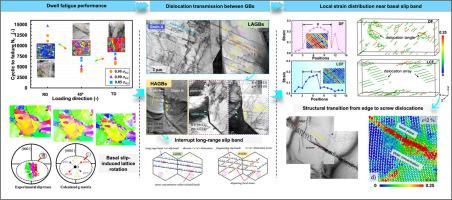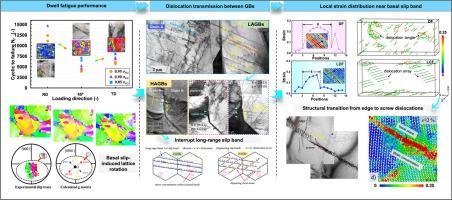Mechanistic insights into stress localization and crack precursors during dwell fatigue: Dislocation evolution from basal slip in near-α titanium alloys
IF 12.8
1区 材料科学
Q1 ENGINEERING, MECHANICAL
引用次数: 0
Abstract
Basal slips govern the onset of dwell-fatigue damage in near-α titanium alloys, yet the mechanisms by which they rapidly evolve into crack nucleation under dwell loading remain insufficiently understood. To address this gap, we apply a multiscale framework combining in-situ dwell-fatigue testing, high-resolution dislocation microscopy, and atomistic simulations to directly uncover how basal dislocation structures develop into crack precursors. Notably, for the first time under dwell-fatigue conditions, we demonstrate that the concurrent activation of multiple basal 〈a〉 slips on a single plane induces marked intragranular lattice rotations and strain localization, thereby accelerating damage accumulation. Conversely, co-activation of prismatic and pyramidal slip systems fragments these bands, redistributes strain, and markedly improves dwell-fatigue resistance. Furthermore, a critical slip-transfer mechanism is clarified, wherein basal dislocation transmission across grain boundaries is strongly governed by misorientation: low-angle boundaries permit near-continuous transmission, promoting dislocation pile-ups and local stress amplification, while high-angle boundaries impede slip and facilitate 〈c + a〉 dislocation nucleation via interfacial shear to restore compatibility. Moreover, molecular dynamics simulations validate the broader and higher-amplitude strain fields of basal bands under dwell loading and further uncover a previously unrecognized stress-assisted edge-to-screw dislocation transformation that sustains localized shear, intensifies strain gradients, and predisposes the slip band to premature crack initiation. Collectively, these findings establish a unified failure pathway for basal slip–induced damage, offering new mechanistic insights into how slip-band evolution and dislocation interactions give rise to crack precursors, and informing alloy-design strategies to mitigate dwell fatigue in near-α titanium alloys.


居住疲劳过程中应力局部化和裂纹前兆的机理研究:近α钛合金基底滑移的位错演化
在近α钛合金中,基滑移控制了久居疲劳损伤的发生,但它们在久居载荷下迅速演变成裂纹形核的机制仍未得到充分的了解。为了解决这一差距,我们应用了多尺度框架,结合原位疲劳测试,高分辨率位错显微镜和原子模拟,直接揭示了基底位错结构如何发展成裂纹前体。值得注意的是,我们首次在持久疲劳条件下证明,在单个平面上同时激活多个基滑移会引起明显的晶内晶格旋转和应变局部化,从而加速损伤积累。相反,棱柱形和锥体滑移系统的共激活使这些条带断裂,重新分配应变,并显着提高耐疲劳性能。此外,还阐明了一个关键的滑移传递机制,其中基底位错跨越晶界的传递受到错取向的强烈控制:低角度晶界允许近乎连续的传递,促进位错堆积和局部应力放大,而高角度晶界阻碍滑移,并通过界面剪切促进位错成核以恢复相容性。此外,分子动力学模拟验证了在静载作用下基带更宽、更高振幅的应变场,并进一步揭示了以前未被认识到的应力辅助边到螺旋位错转变,这种转变维持了局部剪切,加剧了应变梯度,并使滑移带易于过早萌生裂纹。总的来说,这些发现为基础滑移损伤建立了统一的失效途径,为滑移带演化和位错相互作用如何产生裂纹前体提供了新的机制见解,并为合金设计策略提供了信息,以减轻近α钛合金的居住疲劳。
本文章由计算机程序翻译,如有差异,请以英文原文为准。
求助全文
约1分钟内获得全文
求助全文
来源期刊

International Journal of Plasticity
工程技术-材料科学:综合
CiteScore
15.30
自引率
26.50%
发文量
256
审稿时长
46 days
期刊介绍:
International Journal of Plasticity aims to present original research encompassing all facets of plastic deformation, damage, and fracture behavior in both isotropic and anisotropic solids. This includes exploring the thermodynamics of plasticity and fracture, continuum theory, and macroscopic as well as microscopic phenomena.
Topics of interest span the plastic behavior of single crystals and polycrystalline metals, ceramics, rocks, soils, composites, nanocrystalline and microelectronics materials, shape memory alloys, ferroelectric ceramics, thin films, and polymers. Additionally, the journal covers plasticity aspects of failure and fracture mechanics. Contributions involving significant experimental, numerical, or theoretical advancements that enhance the understanding of the plastic behavior of solids are particularly valued. Papers addressing the modeling of finite nonlinear elastic deformation, bearing similarities to the modeling of plastic deformation, are also welcomed.
 求助内容:
求助内容: 应助结果提醒方式:
应助结果提醒方式:


